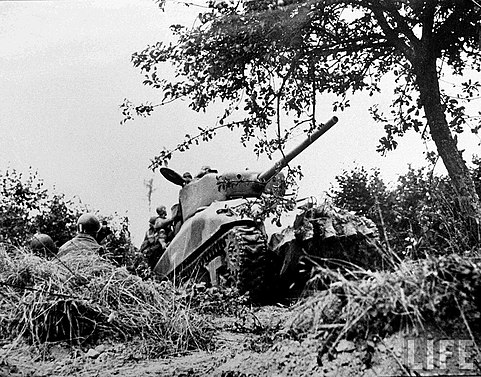June 6th turned into June 7th as the
survivors of the initial landings began to leave the beach heads and move
inland. In their wake came thousands of more allied troops discharging from
their landing crafts in shoulder high water to avoid booby traps and mines close
to the five landing zones. Operation Overlord was one day
old.
Once up and over the bluffs that
overlooked the beaches, the men found themselves confronting miles of hedgerows
stretching from Cherbourg to Alecon and Mayenne , north to south, and from
Falaise and Argentan to Avaranches, east to west. They called
this advance "Operation Cobra".
The hedgerows were ancient from Roman
times and were called "Le Bocage" by the people of
Normandy.
They consisted of earthen banks 5 to 6
feet high and 12 feet wide across the bottom. They were anchored together by
trees on their top and thick dense vegetation on their sides whose root systems
combined to make them as solid as stone walls. They had been built to delineate
land boundaries and provide natural fencing for pasture and farm
land.
Taken as a whole they formed a crazy
patchwork maze with sunken roads caused by the buildup of earth to form the
hedges. These roads were the only means to travel through the maze by wagon or
motor vehicle. Each field rimmed by these hedgerows had one entrance and the
Allies had no maps.


Some riflemen believed that
their higher ups had imagined manicured hedges on level ground such as would be
found back home when they had made their plans. Instead they found themselves
in terrain that contained the worst elements of the trench warfare of the WWI
and the jungle fighting of the war in the Pacific.

Field Marshall Gerd von Rundstedt and his
subordinate Field Marshall Erwin Rommel were of opposite minds as to how to stop
and contain the Allied advance. Rommel wanted to keep them on the beaches
at all costs and prevent them from taking
Cherbourg with its port facilities and St. Lo on the river Vire which was 200
feet above sea level on a plateau.
Von Rundstedt wanted a more mobile
defense. Hitler needed to decide but did not so there was no coherent strategy
at first. Hitler was obsessed with the nightmare of an Allied break through to
the plains of Western Europe and the low countries where the Blitzkrieg he and
his Wehrmacht had invented would be turned against him.
So almost by chance the hedgerows of
Normandy became the new "Atlantic Wall" of "Festung
Europa".
The Allied troops soon discovered that
the enemy they faced was an international army with slave troops consisting of
Russians, Cossacks, Poles, Chinese, Georgians, Mongolians, Koreans and Muslims.
These less than ardent defenders however were soon reinforced by 16,000 battle
hardened, elite paratroopers from the 3rd FJ Division in
Brittany.
Each hedgerow now became a redoubt with
dug in and camouflaged riflemen, heavy machine guns, mortar teams and forward
artillery spotters. Snipers seemed to be in every tree. As soon as troops
entered the fields surrounded by the hedgerows that farmland would become a
killing ground.
The tactics of the battle required that
the infantry and the tank crews work in tandem. That in turn required getting
the tanks off the sunken roads and into the fields where they could tear up the
hedgerows with cannon fire and 50 mm machine guns and destroy the
enemy.
The Allies first began to blow holes in
the hedgerows so their M4 Sherman Tanks could get into the fight. They had
learned the hard way that going up and over exposed their lightly armored under
carriage to anti tank weapons. Sgt. Curtis B. Culin of the 2nd Armored Division
came up with the idea of retrofitting the tanks with "tusks" or "prongs" made
from captured German steel to cut through the banks of the hedgerows, roots and
all. These became famous as the "Rhino" tanks due to their resemblance to a
Rhinoceros.
Other tanks were fitted with bull dozer
blades and they became "Dozer" tanks. Soon the British retrofitted their
Churchill tanks also.
The ingenuity of this adaptation also
thwarted the German strategy of holding the intersections and junctions of the
sunken road network where they could wait to kill the Allied Armour they
believed were constrained to the roads and not the fields. By taking the tanks
off the sunken roads the Allies were able to flank the hundreds of German traps
and keep from being pushed back into the sea.
In Normandy in 1944, there were 14
hedgerows to the Kilometer. The Allies were able to clear two a day.
By July, Cherbourg had been taken along
with St. Lo by Omar Bradley's 1st Army. The British under Field Marshall Sir
Bernard Law Montgomery had taken Caen. The Normandy
Beachheads were finally and
forever secure.
The savage war in Le Bocage would
continue for another month. 75% of Allied casualties were from mortars as the
ancient fields and farms of Normandy were torn asunder and watered with the
blood of two fierce armies.

In the end, Hitler's worst fears came
true. Once through the hedgerows all of western Europe lie ripe for the
taking. The Reich that was to last a thousand years had less than 8 months to
live.
ERLANDSSON
![[Section of Typical Normandy Hedgerow]](http://www.lonesentry.com/normandy_lessons/combat_lessons_normandy_image1x.gif)




No comments:
Post a Comment